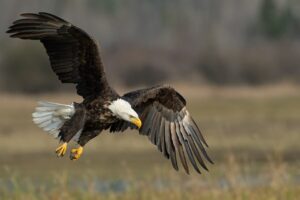Does the Bald Eagle Have Any Predators Or Threats?
The bald eagle is one of the largest bird species on the planet. The term “bald eagle” derives from an older meaning of the word, “white-headed.” Bald eagles are not bald but have brown feathers with white heads and tails. Being such an incredibly large bird with huge talons, you would think the bald eagle would have very few predators or things to worry about.
Bald eagles have two subspecies and a wide habitat range, including most of the contiguous United States, Alaska, Canada, and northern Mexico. As it is a sea eagle, it prefers to nest near large bodies of water with plenty of food and old trees to act as a nesting spot.
Bald Eagle Characteristics
Bald eagles are large birds with body lengths ranging from 70 to 102 cm (28 to 40 in). They weigh between 3 and 6.3 kg (6.6 and 13.9 lb.), with females being approximately 25% larger than males. The wingspan of a bald eagle ranges between 1.8 and 2.3 m. (5 ft 11 in and 7 ft 7 in). The size of the bald eagle varies according to its location.
Bald Eagle Lifespan
The bald eagle has a life expectancy of 15 to 30 years. They can, however, live even longer in captivity.
Bald eagle eggs and juvenile eagles have a low survival rate, but adult birds have a 90% annual survival rate.
Bald Eagle Reproduction
Bald eagles are monogamous, and they are thought to mate for life. They do not migrate with their mate but they meet for the breeding season. The breeding season occurs in and around March, depending on the season earlier than most raptors, which mate in April or May.
These eagles typically lay one brood of one to three eggs per season, which are incubated for approximately 35 days. The eggs are round to oval, whitish in color, and measure 58 to 85 mm long and 47 to 63 mm wide. Incubation occurs from mid-March to early May.
Bald Eagle Predators
Adult bald eagles have few predators, allowing them to nest on the ground without fear. The majority of non-human mortality involves nestlings or eggs. Gulls, magpies, black bears, ravens, crows, raccoons, bobcats, wolverines, and arctic foxes frequently prey on the eggs and young. According to a study, immature bald eagles have an 89% survival rate in rural habitats and a 65 to 72% survival rate in suburban habitats. Following are some of the predators of the Bald Eagle.
Humans
Humans are one of the most significant threats to eagle populations. Humans have consistently endangered eagle populations, whether through shooting or pesticide use. Other birds rarely threaten eagles because they are among the world’s largest birds of prey, but human activities severely harm them.
Owls
Owls are carnivorous birds, so they eat other animals to survive. Amphibians, invertebrates such as crabs, snails, spiders, insects, small mammals, reptiles, fish, and birds, are among their main prey options. Food preferences will differ between owl species. A larger owl, such as the Eagle Owl, will feed on young birds like the bald eagle.
Raccoons
Raccoons are nest thieves who will steal anything they can get their hands on. They are exceptionally skilled at stealing eggs from bird nests. Raccoons are omnivores, which means they eat both plant and meat-based foods. They live in various environments, including caves, treetops, and even homes. Bald eagles frequently have to defend their nests against intruder Racoons who want to steal their eggs.
Wolverines
Wolverines have a heavyweight, muscular body that looks like smaller versions of brown bears. They can also move quickly due to their padded feet, allowing them to pass through thick snow layers and general ground surfaces easily.
Their typical diet can range from, moose, and caribou to fruits, and even bird eggs, depending on their habitat. Bald eagle eggs are among these, as wolverines can hunt down their nests during the early spring months.
Crows
Crows, unlike owls, are omnivorous, meaning they can eat meat and plants. They can also eat almost anything because their dietary restrictions are minimal, which allows them to feast on birds such as young bald eagles and their eggs.
Hawks
Despite their reclusive nature, hawks are among the fascinating birds, with different types living in other parts of the world. Because of the differences in their species classifications, they will have various dietary preferences, including young bald eagles. Buteos, which fly high over open landscapes, are another type of hawk that feeds on young bald eagles and their eggs.
Black-billed Magpies
Black-billed magpies, also known as corvids, are opportunistic feeders with an omnivorous diet that varies greatly depending on their environment. Some feed on grains and wild fruits, while others feed on insects and raid bird nests, including bald eagle nests.
If you loved this article, read where to find the world’s largest pythons!





